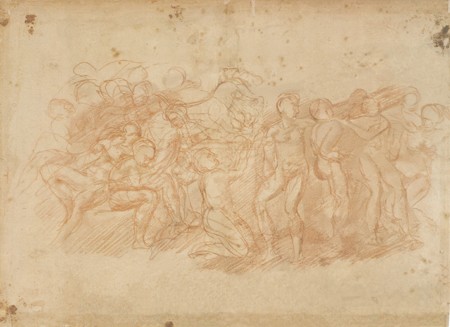Pieces of paper have a memory, registering subtle changes and revealing their history. They are much more than simple two-dimensional supports without volume; they occupy a physical space that records gestures and manipulations. Cuts, folds, scratches, and doodles, even when barely noticeable or apparently unimportant, can tell us surprising and interesting stories. Observing the mark-making of Michelangelo (1475–1564) through
Members' Research Report Archive
Michelangelo and Paper as Palimpsest
Mauro Mussolin, Scuola Normale Superiore di Pisa
Samuel H. Kress Senior Fellow, 2015–2016

Michelangelo Buonarroti and Antonio Mini, Sketches for The Brazen Serpent in Red Chalk, Male Figures in Black Chalk, and Plan for the Fortification of a Gate of Florence in Pen and Ink, c. 1525–1527, Inv. Casa Buonarroti 27A verso. Casa Buonarroti, Florence

Michelangelo Buonarroti, Sketch for The Brazen Serpent in Red Chalk, Inv. Casa Buonarroti 27A verso, c. 1525, digital reconstruction. Casa Buonarroti, Florence
My project examines the ways in which Michelangelo used paper in
architectural and figural drawings, from the procedures he developed during their execution (such as the preparation of the sheets according to function and the choice of drawing and writing instruments) to the visual strategies he adopted in presenting the projects to his patrons in order to captivate their interests. The goal of my research, which will culminate in a book, is to investigate Michelangelo’s intentionality as
During my residency at
challenging groups of drawings by Michelangelo, one that is not only complex in itself but is also characterized by a vast and often discordant bibliography: the nineteen sheets with sketches and projects for the Florentine fortifications held in Casa Buonarroti, Florence (CB 11A-30A). This set of drawings comprises a great typological variety of solutions, including sketches, studies, and survey and demonstration drawings. They also attest to Michelangelo’s interest in large-scale design—both urban and suburban—and his commitment to documenting topographical elements and the landscape’s infrastructures, an aspect that has been overlooked in current scholarship.
In the months at CASVA I have created a digital reconstruction of sheet CB 27A. By separating strata, different graphic instruments, and multiple hands—from the latest layer to the oldest—this process resulted in a sort of archaeology of the paper. What has appeared under this palimpsest is a sketch in red chalk by Michelangelo for the biblical scene The Brazen Serpent, previously attributed to Antonio Mini (d. 1533), which now can be reconsidered as a work of the master. At the same time, I have organized a systematic digital catalog of every sketch contained in all the drawings related to the fortifications of Florence. This mapping process is essential to visualizing and comparing the overwhelming number of projects represented in these sheets and to
The community of CASVA fellows has been a truly engaging and stimulating environment in which to generate discussion and deepen insights on my project, and the National Gallery of Art Library has offered the possibility to expand my knowledge of papermaking and paper conservation. From October to April I was able to conduct a systematic analysis of more than one hundred Italian Renaissance prints and drawings in the Gallery’s Print Study Room. Regular meetings with Gallery curators and conservators of prints and drawings have offered the unique experience of a closer look at materials and media. Furthermore, the Millon Architectural History Grant, supported by the Lois Roth Endowment, has provided the opportunity to increase my expertise by studying the impressive image collection of architectural drawings created by Henry A. Millon and now in the Italian Architectural Drawings Photograph Collection of the National Gallery of Art Library. Among other discoveries, this resource gave me new materials with which to investigate a particular group of architectural documents on paper: collaborative drawings and multiauthor sketchbooks as well as workshop sheets in which the master architect and an assistant drew together on the same page.